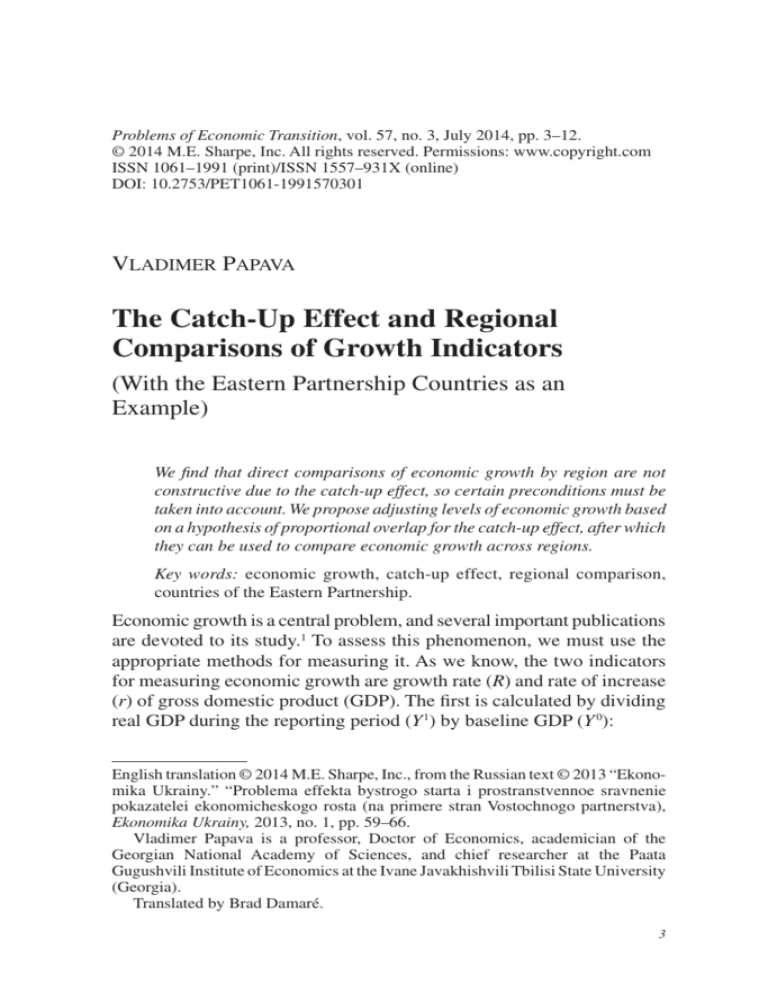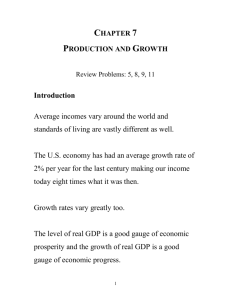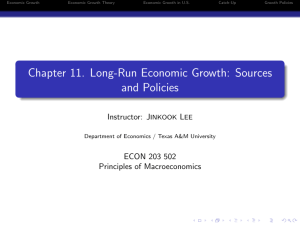
Problems of Economic Transition, vol. 57, no. 3, July 2014, pp. 3–12.
© 2014 M.E. Sharpe, Inc. All rights reserved. Permissions: www.copyright.com
ISSN 1061–1991 (print)/ISSN 1557–931X (online)
DOI: 10.2753/PET1061-1991570301
Vladimer Papava
The Catch-Up Effect and Regional
Comparisons of Growth Indicators
(With the Eastern Partnership Countries as an
Example)
We find that direct comparisons of economic growth by region are not
constructive due to the catch-up effect, so certain preconditions must be
taken into account. We propose adjusting levels of economic growth based
on a hypothesis of proportional overlap for the catch-up effect, after which
they can be used to compare economic growth across regions.
Key words: economic growth, catch-up effect, regional comparison,
countries of the Eastern Partnership.
Economic growth is a central problem, and several important publications
are devoted to its study.1 To assess this phenomenon, we must use the
appropriate methods for measuring it. As we know, the two indicators
for measuring economic growth are growth rate (R) and rate of increase
(r) of gross domestic product (GDP). The first is calculated by dividing
real GDP during the reporting period (Y 1) by baseline GDP (Y 0):
English translation © 2014 M.E. Sharpe, Inc., from the Russian text © 2013 “Ekonomika Ukrainy.” “Problema effekta bystrogo starta i prostranstvennoe sravnenie
pokazatelei ekonomicheskogo rosta (na primere stran Vostochnogo partnerstva),
Ekonomika Ukrainy, 2013, no. 1, pp. 59–66.
Vladimer Papava is a professor, Doctor of Economics, academician of the
Georgian National Academy of Sciences, and chief researcher at the Paata
Gugushvili Institute of Economics at the Ivane Javakhishvili Tbilisi State University
(Georgia).
Translated by Brad Damaré.
3
4 problems of economic transition
R=
Y1 .
Y0
(1)
To calculate the rate of increase, it is necessary to divide the rate of
change in real GDP (∆Y = Y 1 – Y 0) by the baseline real GDP (Y 0):
r=
∆Y
.
Y0
(2)
As we know, the relationship between these two parameters is:
R = 1 + r.
In practice, to determine economic growth we usually use the second
of these two indicators, the rate of increase of real GDP. One of the
problems associated with measuring economic growth is the comparison of growth rates across different countries and regions. In essence,
due to diminishing capital returns, countries with relatively low levels
of economic development find it easier to achieve higher growth rates
than countries with more advanced economies, all other things being
equal. In economics, this phenomenon is called “the catch-up effect”2
(from the English3).
To illustrate the catch-up effect, consider the numbers provided by the
World Bank indexes for economic growth among Eastern Partnership
countries4 (six former Soviet countries are included in the scope of the
European Neighborhood Policy: Armenia, Azerbaijan, Belarus, Georgia,
Moldova, and Ukraine), as well as in Russia and the United States, during
the same period comparing 2009 with 2010 (Table 1). In 2010, all of the
countries in Table 1 except Armenia saw economic growth surpassing
that of the United States (including almost 2.6 times higher in Belarus,
almost 2.4 times in Moldova, and 2.1 times in Georgia). Obviously a
direct comparison of economic growth rates in different countries does
not give a reliable estimate of the real situation, as the “starting” conditions (i.e., the levels of economic development) in these countries are
very different from one another.
Only by adjusting for the catch-up effect in terms of economic
growth can we compare them (this also applies to highly developed and
underdeveloped countries). To adjust for the catch-up effect, we have
to determine which factors will modify economic growth such that one
can successfully compare these figures by country and region, which is
the purpose of this article.
As we know, the usual indicator of economic development is per
Azerbaijan
Armenia
Belarus
Georgia
Moldova
Ukraine
Russia
United
States
Country
4,950
2,803
5,183
2,441
1,526
2,545
8,616
45,192
5.0
2.1
7.7
6.3
7.1
4.1
4.3
3.0
1.0
1.7
0.7
2.6
2.1
2.4
1.4
1.4
1.0
9.1
16.1
8.7
18.5
29.6
17.8
5.2
3.00
0.55
0.13
0.89
0.34
0.24
0.23
0.83
1.00
0.18
0.04
0.30
0.11
0.08
0.08
0.28
1.00
5.45
23.08
3.37
8.82
12.50
13.04
3.61
Ratio of a
Ratio of actual
Ratio of
Proportion of
given country’s U.S. economic
actual economic catch-up effect
hypothetical­
growth to a
Economic
growth in a
(ratio of U.S.
economic
given country’s
growth in 2010
given country per capita GDP
growth to U.S.
hypothetical­
as compared to Per capita GDP to that of the
to that of a
Hypothetical actual economic
economic
2009 (%)
in 2009 (US$)
United States
given country) economic growth
growth
growth
Economic Growth and Level of Economic Development in Eastern Partnership Countries, Russia, and the United
States
Table 1
july 2014 5
6 problems of economic transition
capita GDP (y), which is determined by dividing GDP (Y) by the population (N):
y=
Y
.
N
(3)
It should be noted that, when comparing regions using this indicator,
the result is usually measured in U.S. dollars (see Table 1).5
The U.S. economy (in terms of GDP per capita) is 8.7 times larger than
the economy of Belarus, 29.6 times that of Moldova, and 18.5 times that
of Georgia. Naturally, 1 percent growth in the United States, all else being
equal, amounts to considerably more than in each of these listed countries
because of the catch-up effect.
Logically, we can assume that, inasmuch as U.S. economic development, for example, was 17.8 times higher in 2009 than the corresponding
figure in Ukraine, it was 17.8 times more difficult for the United States
to achieve the same economic growth rate as Ukraine, all elese being
equal. This argument is based on the following hypothesis: if the level
of economic development in one country is α times the level of economic
development in the second, then it will be α times more difficult for the
first country to achieve the same economic growth as the second.
We call this assumption the hypothesis of proportional overlap for the
catch-up effect, or in short, the proportional overlap hypothesis. For its
mathematical description we use αij to denote the ratio of GDP per capita
in country i (yi) to that of country j (yj) during the same span of time:
y
αij = i .
(4)
yj
Due to the nature of this proportional overlap hypothesis, the proportional overlap of country i to the catch-up effect in country j creates
a coefficient that we will call, in short, the proportional overlap coefficient.
If the actual economic growth of country j is equal to rj, then the
economic growth of country j, corresponding to the economic growth
in country i, under the catch-up effect hypothesis will be calculated as
follows:
rrij*ij* =
rj
αij
.
(5)
Consequently, r*ij is the hypothetical economic growth of country j,
july 2014 7
which can be used to measure relative economic growth against country
i. In short, we will call r*ij the hypothetical economic growth quotient for
country j.
If we divide the actual economic growth of country i (ri) by the
hypothetical economic growth quotient for country j (r*ij), we obtain a
value that indicates how many times the economic growth of country
i really exceeds that of country j. Based on Equation (3) we obtain the
equation:
βij =
ri ri
= αij . rij* rj
(6)
Given Equations (2)–(5), we can write Equation (6) as:
∆Yi
N
y
βij = i = i , ∆Yj y j
Nj
where yi and yj represent per capita GDP increase in countries i and j,
respectively.
Therefore, Ukraine’s real economic growth in 2010 was 4.1 percent compared to 2009, and in the United States it was 3 percent, even though the level
of economic development in the United States was 17.8 times higher than
that of Ukraine. Consequently, Ukraine’s 4.1 percent growth corresponds to
0.23 percent growth in the United States (4.1 : 17.8 = 0.23). Table 1 gives
the hypothetical economic growth of other countries similarly.
As noted above, the actual economic growth in Belarus, Moldova, and
Georgia exceeded that of the United States. In reality we see a completely
different picture. Thus, under the proportional overlap hypothesis, the
appropriate ratio for measuring the actual economic growth in Belarus
against the actual economic growth in the United States is 0.30 (0.89 : 3.0),
in Moldova, 0.08 (0.24 : 3.0), and in Georgia, 0.11 (0.34 : 3.0). In other
words, according to the actual figures, economic growth in Belarus
is almost 2.6 times higher than growth in the United States, but after
adjusting economic growth in the United States for the catch-up effect
(3.0 : 0.89), U.S. growth, by contrast, exceeds growth in Belarus by
nearly 3.4 times. For Moldova the ratio is 12.5 times (3.0 : 0.24), for
Georgia, more than 8.8 times (3.0 : 0.34), and so forth.
The numbers given in Table 1 are based on the economic principle of
8 problems of economic transition
choice of a so-called country-standard, which in this example is the United
States. For a “country-standard” one could select the state that has the highest GDP per capita in the world, and in accordance with this standard, the
rates of economic growth in other countries would be adjusted similarly.
This approach has one, purely technical drawback. For example, in 2009
in Luxembourg, GDP per capita was very high and amounted to $104,354
(while in the same year, in some other countries, the figure was even higher),
and in Burundi, it was only $222 (nor was this the smallest value in the
world).6 So for Luxembourg the proportional overlap of the catch-up effect
to the economy of Burundi would be 470.1 (104,354 : 222). This number
is so large that, given the actual economic growth in Burundi (3.8 percent
in 2010)7, the corresponding hypothetical growth would be 0.008 percent
(3.8 : 470.1). For Burundi, this figure is so small that it would round to
zero. This problem also applies to many other countries that have relatively
low GDP per capita and insignificant economic growth.
To avoid such difficulties it is better to take the average per capita GDP
of a group of countries, which involves calculating the total amount of
per capita GDP for the total population. The adjustments in economic
growth of each country will be based on this figure as well. Naturally,
such an approach for determining the amount of catch-up effect will
involve the use of the averaged indicator of economic growth for this
group of countries.
If the group in question consists of m countries (i = 1, 2 , ..., m), then
the average GDP per capita (÷y) will be calculated as follows:
y=
Σim yi Ni ΣimYi
=
, Σim Ni
Σim Ni
(7)
where Yi is GDP in country i, and Ni is the population of country i.
If we take into account the possibility of variance in the composition of
the group of countries in which we are studying the problem of adequate
assessment of the level of economic growth, it would be better for the
purposes of our research if we took the average GDP per capita for the
global economy and the global economic growth rate. In that case, the
basis for comparing indicators will not depend on any changes in the
group of countries being studied. Consequently, if m is the total number
of countries in the world, then we can determine global per capita GDP
by using Equation (7). In 2009 this figure was $8,588.3 per capita for
the total world population.8
Using Equation (4) for the average level of world economic develop-
july 2014 9
ment, the proportional overlap of the catch-up effect in country j (÷αj) will
be calculated as follows:
y
α j = .
(8)
yj
By analogy with the ratio in Equation (5), the hypothetical economic
growth of country j (÷r *j) (i.e., economic growth in country j corresponding
to global economic growth under the proportional overlap hypothesis)
will be defined as:
r
rj* = j .
(9)
α
j
If we denote global economic growth as ÷r, with regard to Equation
(2) we obtain:
Σm ∆Y
r = i i .
ΣimYi 0
In 2010, global economic growth was 4.2 percent.9
Using Equation (6), ×βj shows how many times the world’s economic
growth really differs from economic growth in country j:
r r
= αj .
rj* rj
Table 2 summarizes the economic growth and the level of economic
development in the Eastern Partnership countries, Russia, and the United
States, all of which are adjusted to exclude the influence of the catch-up
effect on their respective indexes, as calculated globally.
When we compare the results shown in Tables 1 and 2, the question
arises as to whether these results are identical. In other words, it is important
to determine whether changes exist in the ratio of hypothetical economic
growth (which excludes the influence of the catch-up effect) depending on
changes in baseline levels of economic development, on which the coefficients of proportional overlap for the catch-up effect were also based.
As we can see, regardless of which method we accept as a basis for
verifying economic growth (i.e., a hypothetical calculation of the economic
growth indicators) in order to eliminate the catch-up effect, either the
economic performance and growth of one country or the average performance of the global economy, the ratio of these revised rates of economic
growth does not change.
To confirm this, we consider hypothetical growth calculated on the
βj =
Azerbaijan
Armenia
Belarus
Georgia
Moldova
Ukraine
Russia
United
States
Globally
Country
4,950.0
2,803.0
5,183.0
2,441.0
1,526.0
2,545.0
8,616.0
45,192.0
8,588.3
5.0
2.1
7.7
6.3
7.1
4.1
4.3
3.0
4.2
0.70
1.00
1.19
0.50
1.83
1.50
1.69
0.98
1.02
0.190
1.000
1.735
3.064
1.657
3.518
5.628
3.375
0.997
Proportion
Ratio of
of catch-up
actual economic effect (ratio of
Economic
growth in a
the global per
Growth in 2010
given country to capita GDP to
as compared to Per capita GDP global economic that of a given
2009 (%)
in 2009 (US$)
growth
country)
15.79
4.20
2.88
0.69
4.65
1.79
1.26
1.21
4.31
Hypothetical­
economic
growth
3.76
1.00
0.69
0.16
1.11
0.43
0.30
0.29
1.03
0.27
1.00
1.46
6.09
0.90
2.35
3.33
3.47
0.97
Ratio of the
Ratio of a
actual global
given country’s
economic
hypothetical­
growth to a
economic
given country’s
growth to actual
hypothetical­
global economic
economic
growth
growth
Economic Growth and Level of Economic Development in Eastern Partnership Countries, Russia, the United States,
and Globally
Table 2
10 problems of economic transition
july 2014 11
basis of any individual country, and growth based on the aggregate performance of the global economy.
Substituting Equation (4) into Equation (5), we obtain:
ry
rij* = i j . (10)
yi
From Equation (10), the hypothetical economic growth of country j
as it corresponds to growth in country i, and the actual economic growth
of country i are equal to one other:
rij* rj y j
= ⋅ .
(11)
ri ri yi
Similarly, substituting Equation (8) into Equation (9) for countries j
and i, respectively, we obtain:
ry
rj* = j j , (12)
y
ri * =
ri yi
.
y (13)
We combine Equations (12) and (13), that is, we calculate the ratio of
hypothetical economic growth of country j to the hypothetical economic
growth of country i as they correspond to global economic growth:
rj* rj y j
= = .
(14)
ri * ri
yi
Comparing Equations (11) and (14):
rij* rj*
= .
ri ri *
(15)
Based on Equation (15), we can formulate an invariance theorem:
the ratio of hypothetical economic growth, excluding the influence of the
catch-up effect, does not depend on the choice of basic economic growth
indicators or the countries’ levels of development, which were used to
calculate the proportional overlap for the catch-up effect.
As an illustration of Equation (15), we can compare the ratio of economic growth, excluding the influence of the catch-up effect, in Ukraine
and the United States, for example (see Tables 1 and 2). Table 1 shows
that the ratio is 0.08, and Table 2 also shows 0.08 (1.21 : 15.79).
The invariance theorem suggests that this approach eliminating the
12 problems of economic transition
catch-up effect in terms of economic growth for the purpose of comparing
different regions is not a controversial one, and can be applied in practice
without too much difficulty.
The approach for assessing the catch-up effect that we have proposed
in this article can be further developed by improving the proportional
overlap hypothesis.
Notes
1. See, for example, J.E. Stiglitz, A. Sen, and J.P. Fitoussi, Mismeasuring
Our Lives: Why GDP Doesn’t Add Up. The Report by the Commission of the
Measurement of Economic Performance and Social Progress. New York: New
Press, 2010; R. Dzh. [R.J.] Barro and Kh. Sala-i-Martin [X. Sala-i-Martín],
Ekonomicheskii rost (Moscow: Binom. Laboratoriia znanii, 2010); M. Flerbe, “Za
predelami VVP: v poiskakh mery obshchestvennogo blagosostoianiia,” Parts 1 and
2, Voprosy ekonomiki, 2012, nos. 2 and 3.
2. See N.G. Menk’iu [Mankiw], Printsipy ekonomiki (St. Petersburg: Piter
Kom, 1999), pp. 523–24.
3. See N.G. Mankiw, Principles of Economics (Mason, OH: Thomson SouthWestern, 2004), pp. 546–47.
4. See World Bank, “GDP Growth (Annual Percentage),” 2012; available at
http://data.worldbank.org/indicator/NY.GDP.MKTP.KD.ZG/.
5. See World Bank, “GDP per Capita (Current US$),” 2012; available at http://
data.worldbank.org/indicator/ NY.GDP.PCAP.CD/.
6. Ibid.
7. See World Bank, “GDP Growth.”
8. See World Bank, “GDP per Capita.”
9. See World Bank, “GDP Growth.”








